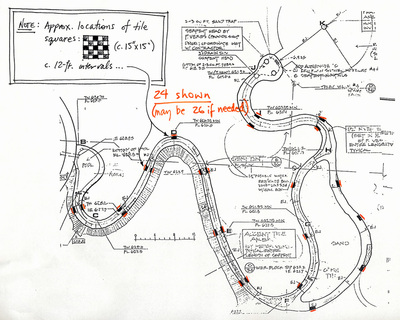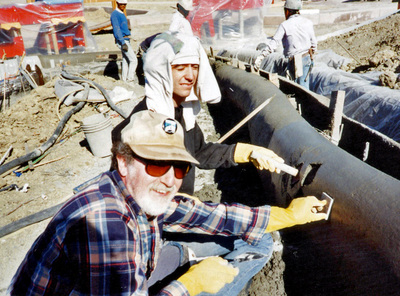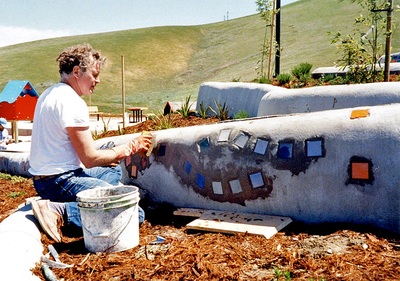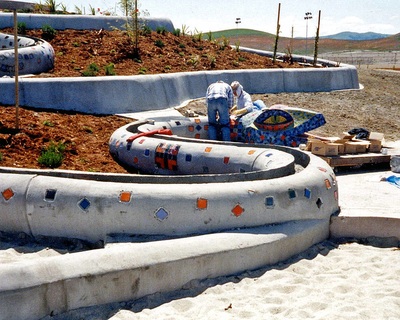LARGE SERPENT – SCARLATTI 1990
LARGE SERPENT – SCARLATTI
Diablo Vista Park in Danville, CA
Diablo Vista Park in Danville, CA
Images above from waymaking.com
BACKGROUND
In March of 1989, Doug Wolf, a landscape architect in Berkeley, contacted me. He had been on the committee that chose me for the Slide-Climber project in Berkeley in 1978.
He had a large project in Crow Canyon Park in Danville, with several special features that I may want to work on, including a 200-ft. serpent with a water feature, two domes on columns, a 24-ft.-diameter tiled basin for water, and six small critters to be set on pedestals.
Almost as soon as I started my preliminary designs, all of these items were cut from the project’s budget.
In July the Serpent was reinstated, and in August I submitted drawings for its head as shown in the architect’s plans, and also for tile work along the length of its long body.
There followed the ritual dance of contractor–subcontractor–sub-subcontractor communications and miscommunications about the details of who does what and when and for how much, and in October I finally had a contract, which was then revised and re-revised, and finally finalized in November.
It was stipulated that I was to build and deliver the Serpent’s head and others were to build the long body upon which I would set the tiles. I would also supply the river stones to be set into the water channel running the length of the serpent.
DESIGN
In March of 1989, Doug Wolf, a landscape architect in Berkeley, contacted me. He had been on the committee that chose me for the Slide-Climber project in Berkeley in 1978.
He had a large project in Crow Canyon Park in Danville, with several special features that I may want to work on, including a 200-ft. serpent with a water feature, two domes on columns, a 24-ft.-diameter tiled basin for water, and six small critters to be set on pedestals.
Almost as soon as I started my preliminary designs, all of these items were cut from the project’s budget.
In July the Serpent was reinstated, and in August I submitted drawings for its head as shown in the architect’s plans, and also for tile work along the length of its long body.
There followed the ritual dance of contractor–subcontractor–sub-subcontractor communications and miscommunications about the details of who does what and when and for how much, and in October I finally had a contract, which was then revised and re-revised, and finally finalized in November.
It was stipulated that I was to build and deliver the Serpent’s head and others were to build the long body upon which I would set the tiles. I would also supply the river stones to be set into the water channel running the length of the serpent.
DESIGN
Drawings for the head of the Serpent and preliminary designs for the tile work on its body.
In January 1990, the construction of the Serpent’s body began in Danville, and I started building the head in Mendocino. The basic structure was made of planes of fiberboard wired and glued together. This fiberboard form was clad in fiberglass coated with sand, then tiled.
INSTALLATION
The Serpent was part of a large landscaping project, which was still in process in April when I drove the head down to Crow Canyon Park. Most of the Serpent’s body had already been formed and the gunite crew was coating it with a layer of blown concrete.
While this coat was still wet my helpers and I pressed my tile-sized wood stamps into the concrete at designated intervals and patterns, forming the depressions that would be filled with tiles when the concrete hardened.
The head of the Serpent was set in its place at the front end of its body and I set tiles over the joint.
We also set smooth river stones into the water channel running along the top of the serpent’s body, from its source at the top of the hill down to its head and out its mouth.
When I left the project site, it was still under construction, not at all looking like it does now with vegetation growing around the Serpent.
The Serpent was part of a large landscaping project, which was still in process in April when I drove the head down to Crow Canyon Park. Most of the Serpent’s body had already been formed and the gunite crew was coating it with a layer of blown concrete.
While this coat was still wet my helpers and I pressed my tile-sized wood stamps into the concrete at designated intervals and patterns, forming the depressions that would be filled with tiles when the concrete hardened.
The head of the Serpent was set in its place at the front end of its body and I set tiles over the joint.
We also set smooth river stones into the water channel running along the top of the serpent’s body, from its source at the top of the hill down to its head and out its mouth.
When I left the project site, it was still under construction, not at all looking like it does now with vegetation growing around the Serpent.

























